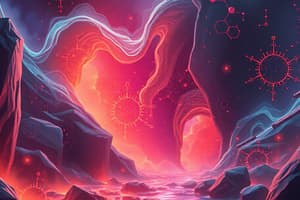Podcast
Questions and Answers
What is the first step in balancing an ionic equation?
What is the first step in balancing an ionic equation?
- Identify the reactants and products (correct)
- Write the net ionic equation
- Adjust coefficients of the compounds
- Separate the ions into strong electrolytes
What is the purpose of the net ionic equation?
What is the purpose of the net ionic equation?
- To balance the total number of atoms present
- To represent all ions in the solution
- To show only the spectator ions involved
- To exclude spectator ions and show reacting species (correct)
When writing a full ionic equation, which ions should be included?
When writing a full ionic equation, which ions should be included?
- All ions present in solution (correct)
- Only spectator ions
- Only solid precipitates
- Only molecular compounds
What do spectator ions do in an ionic reaction?
What do spectator ions do in an ionic reaction?
Which step follows the separation of strong electrolytes into ions?
Which step follows the separation of strong electrolytes into ions?
Flashcards are hidden until you start studying
Study Notes
Ionic Equation
How To Balance Ionic Equations
- Identify the Reactants and Products: Start with a balanced molecular equation.
- Separate into Ions: Break strong electrolytes (soluble salts, strong acids, and strong bases) into their constituent ions.
- Example: NaCl → Na⁺ + Cl⁻
- Write the Ionic Equation: Include all ions present in solution.
- Balance Charges and Atoms:
- Ensure that the number of each type of atom is the same on both sides.
- Confirm that the total charge is balanced.
- Adjust Coefficients: Change the coefficients of the compounds to achieve balance without altering the compounds themselves.
Net Ionic Equations
- Define Net Ionic Equation: Represents only the species that undergo a change during the reaction, excluding spectator ions.
- Identify Spectator Ions: Ions that appear on both sides of the ionic equation and do not participate in the reaction.
- Remove Spectator Ions: Eliminate these ions from the ionic equation to form the net ionic equation.
- Write the Net Ionic Equation:
- Include only the ions and molecules that participate in the reaction.
- Ensure it is balanced in terms of both mass and charge.
- Example:
- Full Ionic Equation: 2 Na⁺ + 2 Cl⁻ + Ca²⁺ + 2 NO₃⁻ → CaCl₂ + 2 Na⁺ + 2 NO₃⁻
- Net Ionic Equation: Ca²⁺ + 2 Cl⁻ → CaCl₂
Balancing Ionic Equations
- Start with a balanced molecular equation to identify reactants and products.
- Strong electrolytes like soluble salts, strong acids, and strong bases should be separated into their ions.
- Example separation: Sodium chloride (NaCl) dissociates into sodium ions (Na⁺) and chloride ions (Cl⁻).
- The ionic equation includes all ions present in solution, capturing the full chemical interaction.
- Balancing requires ensuring both the number of atoms and total charge are equal on both sides of the equation.
- Adjust coefficients of the compounds as needed to maintain balance without changing the compounds themselves.
Net Ionic Equations
- A net ionic equation shows only the participants in the reaction, excluding ions that do not change, known as spectator ions.
- Spectator ions are those which appear on both sides of the ionic equation without undergoing any transformation.
- To form a net ionic equation, remove spectator ions from the complete ionic equation.
- The resulting net ionic equation includes only the relevant ions and molecules that participate in the reaction, ensuring it is mass and charge balanced.
- Example of a full ionic equation: 2 Na⁺ + 2 Cl⁻ + Ca²⁺ + 2 NO₃⁻ → CaCl₂ + 2 Na⁺ + 2 NO₃⁻.
- Example of a simplified net ionic equation: Ca²⁺ + 2 Cl⁻ → CaCl₂.
Studying That Suits You
Use AI to generate personalized quizzes and flashcards to suit your learning preferences.



